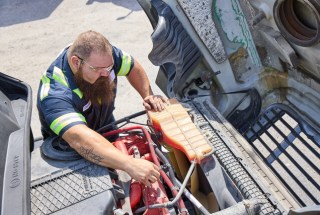Reinforcing the Importance of Preventative Maintenance
Avoiding the pitfalls and downtime exposed by failed DOT inspections with a strong maintenance program.
Drew Kortyna
Sr. Director, Operations Management
Cox Automotive Mobility, Fleet Services
Each year every commercial fleet vehicle is required, by law, to undergo a Department of Transportation (DOT) inspection. These inspections are vital to public safety, the health and longevity of commercial vehicles, while ensuring fleet owners, drivers and technicians follow protocol and maintain safety standards.
Failing a DOT inspection can cause ripple effects through your fleet and business. A downed vehicle can cause scheduling conflicts, logistics issues and prevents your driver (and your business) from making money. A company with a strong preventative maintenance (PM) program reduces the risk of emergency breakdowns while reducing overall maintenance expense.
PM programs are established by the client, meaning there is flexibility to your schedule and location preferences – mobile providers will even drive directly to your lot. Let’s face it, waiting until one of your vehicles breaks down to perform any maintenance is a failure. Here are some of the benefits to standing up a preventative maintenance program:
Fuel Efficiency
In today’s world, one of the most economically beneficial pieces to a PM program is increased fuel efficiency. A well-maintained vehicle consumes less fuel. With fuel prices at a premium, efficiency is at an upmost importance.
Optimal fuel efficiency extends the life of that fleet vehicle, meaning your business gets more miles from that unit which gives you more time before needing to replace the vehicle, reducing overall capital expense.
Tire Repairs
Outside of fuel and driver salaries, tires are one of the largest expenses when operating a commercial vehicle. The most common reason tires fail is lack of inflation. Implementing a strong tire inspection program can help reduce run flat failures.
Proper inflation also helps increase fuel mileage. A single tire that is underinflated by 10% loses 1% in fuel economy. This can add up quickly for large fleets and eats at your bottom line.
Another vital piece to extending tire life is vehicle alignment. Improper alignment can shorten the lifespan of our tires and dramatically reduce fuel economy. Alignment problems can be detected with quality PM programs.
Driver Satisfaction
A major advantage to preventative maintenance programs that often goes overlooked is driver satisfaction. Fleets without a PM program experience more downtime and a driver without a truck doesn’t get paid. With limited drivable hours available, breakdowns cause a lot of stress and frustrations for drivers. Couple that with a decreasing driver population and it becomes obvious why keeping your fleet in top shape is so important to your business.
Safety & Compliance
At the end of the day, the safety of your fleet, your drivers and your business come first. With a PM program and quality technicians, your fleet will be safer on the roads – optimizing your uptime and keeping your drivers and business productive.
Standing up a preventative maintenance program with a partner you trust reduces the likelihood of a failed DOT inspection and keep your vehicles safe and compliant – meaning less headaches and more peace of mind.



